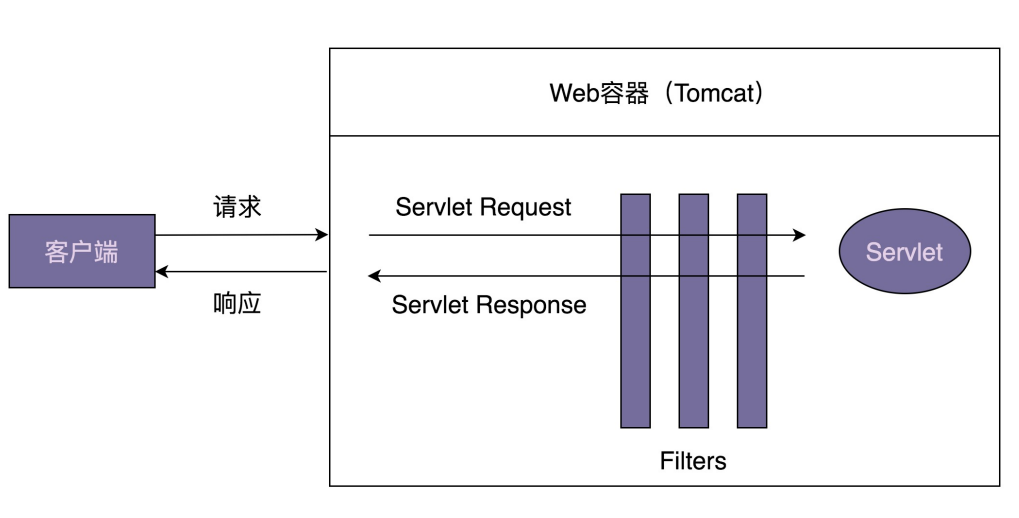职责链模式常用在框架的开发中,为框架提供扩展点,让框架的使用者在不修改框架源码的情况下,基于扩展点添加新的功能。实际上,更具体点来说,职责链模式最常用来开发框架的过滤器和拦截器。
Servlet Filter 其中核心设计代码如下:
1 2 3 4 5 6 7 8 9 10 11 12 13 14 15 16 17 18 19 20 21 22 23 24 25 26 27 28 29 30 31 32 public final class ApplicationFilterChain implements FilterChain { private int pos = 0 ; private int n; private ApplicationFilterConfig[] filters; private Servlet servlet; @Override public void doFilter (ServletRequest request, ServletResponse response) { if (pos < n) { ApplicationFilterConfig filterConfig = filters[pos++]; Filter filter = filterConfig.getFilter(); filter.doFilter(request, response, this ); } else { servlet.service(request, response); } } public void addFilter (ApplicationFilterConfig filterConfig) { for (ApplicationFilterConfig filter:filters) if (filter==filterConfig) return ; if (n == filters.length) { ApplicationFilterConfig[] newFilters = new ApplicationFilterConfig [n + IN]; System.arraycopy(filters, 0 , newFilters, 0 , n); filters = newFilters; } filters[n++] = filterConfig; } }
Spring Interceptor 这个也是一个拦截器,和Servlet Filter不同的是,Servlet Filter 是 Servlet 规范的一部分,实现依赖于 Web 容器。 Spring Interceptor 是 Spring MVC 框架的一部分,由 Spring MVC 框架来提供实现。客 户端发送的请求,会先经过 Servlet Filter,然后再经过 Spring Interceptor,最后到达具 体的业务代码中。
它的底层实现也是基于职责链模式实现。
其中,HandlerExecutionChain 类是职责链模式中 的处理器链。它的实现相较于 Tomcat 中的 ApplicationFilterChain 来说,逻辑更加清 晰,不需要使用递归来实现,主要是因为它将请求和响应的拦截工作,拆分到了两个函数中实现。关键代码如下:
1 2 3 4 5 6 7 8 9 10 11 12 13 14 15 16 17 18 19 20 21 22 23 24 25 26 27 28 29 30 31 32 33 34 35 36 37 38 39 40 41 42 43 public class HandlerExecutionChain { private final Object handler; private HandlerInterceptor[] interceptors; public void addInterceptor (HandlerInterceptor interceptor) { initInterceptorList().add(interceptor); } boolean applyPreHandle (HttpServletRequest request, HttpServletResponse response) { HandlerInterceptor[] interceptors = getInterceptors(); if (!ObjectUtils.isEmpty(interceptors)) { for (int i = 0 ; i < interceptors.length; i++) { HandlerInterceptor interceptor = interceptors[i]; if (!interceptor.preHandle(request, response, this .handler)) { triggerAfterCompletion(request, response, null ); return false ; } } } return true ; } void applyPostHandle (HttpServletRequest request, HttpServletResponse response) { HandlerInterceptor[] interceptors = getInterceptors(); if (!ObjectUtils.isEmpty(interceptors)) { for (int i = interceptors.length - 1 ; i >= 0 ; i--) { HandlerInterceptor interceptor = interceptors[i]; interceptor.postHandle(request, response, this .handler, mv); } } } void triggerAfterCompletion (HttpServletRequest request, HttpServletResponse response) throws Exception { HandlerInterceptor[] interceptors = getInterceptors(); if (!ObjectUtils.isEmpty(interceptors)) { for (int i = this .interceptorIndex; i >= 0 ; i--) { HandlerInterceptor interceptor = interceptors[i]; try { interceptor.afterCompletion(request, response, this .handler, ex); } catch (Throwable ex2) { logger.error("HandlerInterceptor.afterCompletion threw exception" , ex2); } } } } }


